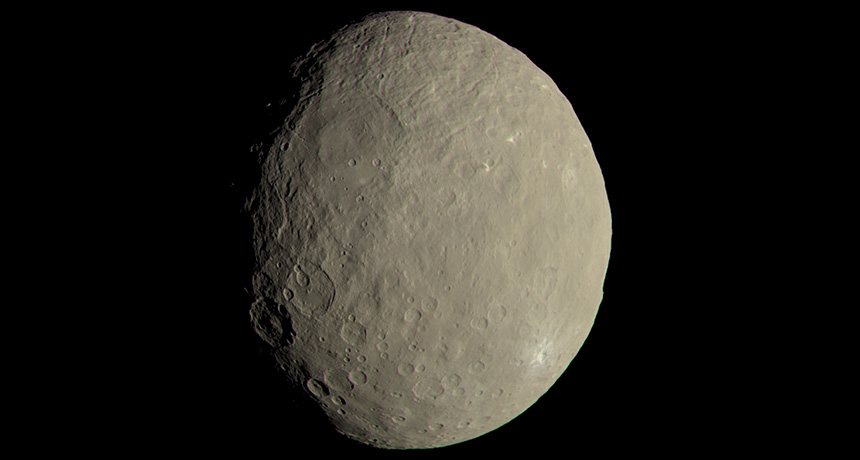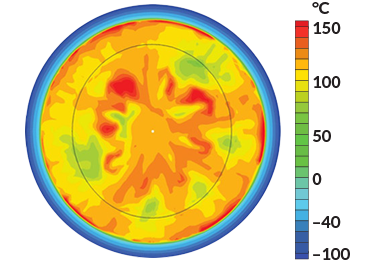Giant mud balls roamed the early solar system
Rethinking early asteroids’ rockiness could solve some meteorite mysteries

MUDDY OCEAN? The dwarf planet Ceres could have once been a ball of mud with a solid core, a new model suggests.
IDA/DLR/MPS/UCLA/JPL-Caltech/NASA
The earliest asteroids were probably made of mud, not rock.
Radioactive heat in the early solar system could have melted globs of dust and ice before they had a chance to turn to rock, a new simulation published July 14 in Science Advances shows. The results could solve several puzzles about the composition of meteorites found on Earth and may explain why asteroids are different from comets.
Most knowledge about the first solid bodies in the solar system comes from meteorites called carbonaceous chondrites, thought to be chunks of the first asteroids. Their chemical compositions are almost identical to the sun’s — if you took all the hydrogen and helium out of the sun, you’d get the mineral ratios found in these bits of rock.
That similarity suggests the first asteroids formed directly from the disk of gas and dust that preceded the planets. The composition also suggests that these rocks formed in the presence of water and at relatively low temperatures, around 150° Celsius.
It’s hard to explain all those features at once. If the original asteroids were bigger than about 20 kilometers across — and there’s no reason to think they weren’t — decaying radioactive elements inside them would have made the rock hotter than that. Some planetary scientists have suggested that the asteroids were porous, and water flowing through a primitive plumbing system cooled them. But the water should have stripped some elements from the rock, ruining their sunlike chemistry.
“It was a paradox,” says planetary scientist Philip Bland of Curtin University of Technology in Perth, Australia.
Bland was modeling how those original globs of ice and dust could have compressed into solid rock, when it hit him: What if they weren’t rock at all?
“At that moment, nothing has happened to force those grains together to turn it into a rock,” he says. That was just something everyone had assumed.
Bland reasoned that heat from radioactive decay would melt the ice, and the resulting body would be an enormous dollop of mud. The mud would suspend sediment particles, so they wouldn’t be stripped of their sunlike elements. And it would allow the early asteroids to be any size and remain cool.
Bland and Bryan Travis of the Planetary Science Institute, who is based in Los Alamos, N.M., ran computer models of how the mud balls would evolve. Convection currents, like those that move molten rock within the Earth’s mantle, would develop, helping to transfer heat into space, the models showed. After several million years, the ball would harden completely, yielding the asteroids seen today.
“It nails the paradox,” Bland says.
Mud balls could even explain the difference between asteroids and comets, he says. Comets, which are more icy than rocky and tend to live farther from the sun, may simply have formed later in the solar system’s history, when there was less radioactive heat available to melt them.
The model also showed that some asteroids would be muddy all the way through, while others would develop cores of larger grains, with a great mud ocean on top of them.
The latter result could describe not just asteroids but bodies like the dwarf planet Ceres, the largest object in the asteroid belt. Observations from NASA’s Dawn spacecraft showed that Ceres has a rocky core and may once have had an ocean that has since evaporated, says UCLA planetary scientist Edward Young. “That process may have been something like what they’re describing.”
Planetary scientist Brandon Johnson of Brown University in Providence, R.I., thinks the model will inspire more research. “I’m interested in it myself, actually,” he says. “It makes a lot of sense and paints a clear picture of what might have been happening.”
But Young is concerned that the model’s flexibility means it won’t make specific enough predictions for future work to test it. “It has so many knobs, you can get it to do whatever you want,” he says. “I’m trying to think of what the killer observation would be.”








